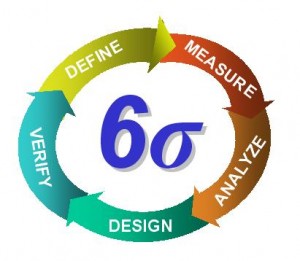 DMADV methodology is an acronym for five interlinked process steps: Define, Measure,Analyze, Design and Verify. It’s a strategy for the creating new product and designing new processes. The objective of this methodology is to create designs which are predictable and do not have any defects.
DMADV methodology is an acronym for five interlinked process steps: Define, Measure,Analyze, Design and Verify. It’s a strategy for the creating new product and designing new processes. The objective of this methodology is to create designs which are predictable and do not have any defects.
Define
In First step the design goals are defined so that they are consistent with the demands of the customer and goals of the company.
Measure
In this step four things are measured and identified which includes the CTQs(Critical to Quality), production process capability, product capabilities and risks.
Analyze
This step deals with the process of Analysis to develop and design alternatives. A high level design is created and evaluation of design capability is being done so that to select the best design.
Design
In this step the Design details are considered. The design is optimized and plan for the verification of designed is developed. Simulations may be required during this step.
Verify
This is the last step of the methodology and it includes the verification of the design, setting of the pilot runs, implementing the production process and verifying its abilities to meet the target goals. After verifying the design it is given to the owner of the process.
Difference between DMAIC and DMADV
DMAIC and DMADV are two different methodologies for implementing the six sigma. They have similar first three letters in their acronyms however they differ fundamentally from each other in their usage as per the product or process state and requirement. DMAIC is used for the existent processes and DMADV is used for the new processes.
If we look at the steps we can make out both the methodologies have similar first three steps and they differ in the last two steps. While DMAIC focuses on improving and controlling the process, DMADV stresses on designing and verifying the process design.
When to use DMADV
(1) When a new product needs to be created or a new process is designed
(2) When desired results are not obtained with the DMAIC methodology on existent product and processes.
 Six Sigma Methodology follows the measurement based strategy that strives for the perfection in the process quality. It is a methodology which is rounded about statistics. It aims to make life better and easier for everyone involved in the process. There are many ways of performing a task in a more efficient manner and by regularly focusing on the efforts to improve quality we can bring about process improvement and variation reduction.
Six Sigma Methodology follows the measurement based strategy that strives for the perfection in the process quality. It is a methodology which is rounded about statistics. It aims to make life better and easier for everyone involved in the process. There are many ways of performing a task in a more efficient manner and by regularly focusing on the efforts to improve quality we can bring about process improvement and variation reduction. There are various sigma levels of the processes. A sigma level of the process determines the accuracy and quality of the process. By knowing the sigma level of the process we can make out how the process is performing for eg. How many defects are occurring during the process. Higher the sigma number of the process, higher will be the accuracy and quality of it.
There are various sigma levels of the processes. A sigma level of the process determines the accuracy and quality of the process. By knowing the sigma level of the process we can make out how the process is performing for eg. How many defects are occurring during the process. Higher the sigma number of the process, higher will be the accuracy and quality of it. One of the main goals of various Corporations around the world is to improve the customer satisfaction retaining them and keeping the customers delighted all the time. After all it is the customer who is driving the market scenario. In the quest of achieving the high quality performance of products and services, Six Sigma got evolved which basically focuses on reducing the variation thereby achieving the stability in the process results.
One of the main goals of various Corporations around the world is to improve the customer satisfaction retaining them and keeping the customers delighted all the time. After all it is the customer who is driving the market scenario. In the quest of achieving the high quality performance of products and services, Six Sigma got evolved which basically focuses on reducing the variation thereby achieving the stability in the process results. Six Sigma is a philosophy of business management which aims to improve the quality of the process. It focuses on identifying and eliminating the causes of defects and variations in business and manufacturing processes across the various sectors of the industry and is being used as the effective quality management strategy.
Six Sigma is a philosophy of business management which aims to improve the quality of the process. It focuses on identifying and eliminating the causes of defects and variations in business and manufacturing processes across the various sectors of the industry and is being used as the effective quality management strategy. The success of a company depends on the strategic planning of the projects. Projects are the works assigned by a company, to meet the needs of the clients. For the successful implementation of the project, there should be a complete planning, adequate links between strategy and actions, and effective communication. Lacking of all these main factors, results in the poor performance of the production work and the customer’s dissatisfaction about the product. Six sigma accomplishes one project at a time. The stories of companies who have saved billions of dollars, have proved the effectiveness of the properly selecting and defining business issues. When the business issues are properly selected and defined, these issues can be assigned to Green Belts and Black Belts for solving it effectively. Six sigma projects are the perfect selection that a company or an organization can take to reach its strategic goals.
The success of a company depends on the strategic planning of the projects. Projects are the works assigned by a company, to meet the needs of the clients. For the successful implementation of the project, there should be a complete planning, adequate links between strategy and actions, and effective communication. Lacking of all these main factors, results in the poor performance of the production work and the customer’s dissatisfaction about the product. Six sigma accomplishes one project at a time. The stories of companies who have saved billions of dollars, have proved the effectiveness of the properly selecting and defining business issues. When the business issues are properly selected and defined, these issues can be assigned to Green Belts and Black Belts for solving it effectively. Six sigma projects are the perfect selection that a company or an organization can take to reach its strategic goals. Product or Service Design six sigma project ideas
Product or Service Design six sigma project ideas Many a times it is seen that companies advertise as Six Sigma Certified. People read the word Six Sigma but never know what it means. Six Sigma refers to the ability of producing highly capable processes that can provide maximum level of quality with minimum defect levels. It is mainly used to gain Quality control, Zero Defect & Total Quality Management.
Many a times it is seen that companies advertise as Six Sigma Certified. People read the word Six Sigma but never know what it means. Six Sigma refers to the ability of producing highly capable processes that can provide maximum level of quality with minimum defect levels. It is mainly used to gain Quality control, Zero Defect & Total Quality Management. Change is considered very important to survive in the competitive world. Every organization has to change its methodologies according to the prevailing market demand. Most of the time people realize that a change in its working methods is necessary but have no idea what to do or how to proceed.
Change is considered very important to survive in the competitive world. Every organization has to change its methodologies according to the prevailing market demand. Most of the time people realize that a change in its working methods is necessary but have no idea what to do or how to proceed. Six Sigma Consultants & Consultancies are a proven support system to implement changes in an organization & also prepare them in facing the challenging world. They are not only seen at National level but are also engaged in providing International services.
Six Sigma Consultants & Consultancies are a proven support system to implement changes in an organization & also prepare them in facing the challenging world. They are not only seen at National level but are also engaged in providing International services. Six sigma seminars are instructional process, conducted for the candidates to know and discover how to apply systematically the statistical methods of six sigma for the organizational growth and for customer satisfaction. Instructions are given to the candidates about the importance and usage of data, information, analysis, and communication for a successful problem solving.
Six sigma seminars are instructional process, conducted for the candidates to know and discover how to apply systematically the statistical methods of six sigma for the organizational growth and for customer satisfaction. Instructions are given to the candidates about the importance and usage of data, information, analysis, and communication for a successful problem solving. The seminar section of statistical process control aims at developing the skills in the participants, how to design and implement sufficient feedback methods that directs quality improvement in products or services. It gives importance to process management also. This is because, in order to bring out the customer satisfaction and remain competitive it is essential to have a stable and predictable process. Using statistical process control, it helps the participants to provide the mans for the scientific control of product and the service quality.
The seminar section of statistical process control aims at developing the skills in the participants, how to design and implement sufficient feedback methods that directs quality improvement in products or services. It gives importance to process management also. This is because, in order to bring out the customer satisfaction and remain competitive it is essential to have a stable and predictable process. Using statistical process control, it helps the participants to provide the mans for the scientific control of product and the service quality. Six sigma metrics are the different types of measurements used in six sigma methodology, in order to measure the success of the company’s product quality. It doesn’t means, the simple collection and calculation of the data and defects are enough for the attainment of the success. In order to get the right measurement through the use of six sigma metrics, a successful business should apply these metrics in the right context in a innovative ways so as to solve the customer’s critics to the quality of the products. Therefore there are certain steps and six sigma metrics, in six sigma methodology to be applied for the defect-free products. six sigma calculator is the tool used for the measurement of the quality of the product in six sigma metrics. some of the areas in which the calculation is done are:
Six sigma metrics are the different types of measurements used in six sigma methodology, in order to measure the success of the company’s product quality. It doesn’t means, the simple collection and calculation of the data and defects are enough for the attainment of the success. In order to get the right measurement through the use of six sigma metrics, a successful business should apply these metrics in the right context in a innovative ways so as to solve the customer’s critics to the quality of the products. Therefore there are certain steps and six sigma metrics, in six sigma methodology to be applied for the defect-free products. six sigma calculator is the tool used for the measurement of the quality of the product in six sigma metrics. some of the areas in which the calculation is done are: Sigma Level Calculator:
Sigma Level Calculator: Lean six sigma is a methodology of business improvement, which is the combination of lean manufacturing and six sigma tools. The aim of lean six sigma is the production of products which yields the “better quality faster”.
Lean six sigma is a methodology of business improvement, which is the combination of lean manufacturing and six sigma tools. The aim of lean six sigma is the production of products which yields the “better quality faster”. Value stream mapping is used with manufacturing, logistics, supply chain, service related industries, software development and product development. The associated analysis methods of value stream mapping are as follows:
Value stream mapping is used with manufacturing, logistics, supply chain, service related industries, software development and product development. The associated analysis methods of value stream mapping are as follows: